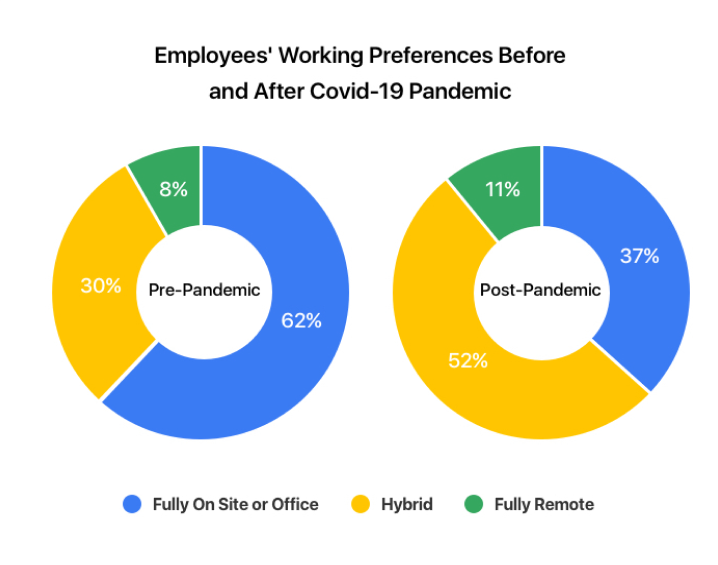10 Hybrid Work Schedule Examples: Benefits, Challenges, and Strategies for Success

The hybrid work model has rapidly gained popularity, offering employees the flexibility to split their time between working remotely and in the office. This approach caters to a range of preferences, helping businesses strike a balance between productivity, collaboration, and employee satisfaction. However, implementing an effective hybrid work schedule comes with its own set of challenges, such as ensuring fairness, maintaining cybersecurity, and fostering collaboration. In this article, we explore 10 examples of hybrid work schedules, the benefits they offer, potential challenges, and strategies to maximize their success in the workplace.
What is a Hybrid Work Model?
A hybrid work model is a flexible arrangement that allows employees to split their time between working remotely and working in the office. This setup combines the best of both worlds, offering employees the autonomy to work from home while maintaining the benefits of in-person collaboration. Hybrid work schedules are typically customized to meet the needs of both employees and employers, promoting productivity and a healthier work-life balance.
With the growing demand for flexibility in the workplace, many companies are adopting hybrid work models to better accommodate the modern workforce. The hybrid model can vary greatly depending on the organization, with some employees working remotely most of the time and others coming into the office on set days. Ultimately, the goal is to offer flexibility while ensuring team cohesion, productivity, and innovation.

Benefits of Hybrid Work Schedules
Increases Productivity Due to Right Balance
A hybrid work schedule offers employees the flexibility to choose the most suitable environment for their tasks. Some employees are more productive in a quiet, controlled home setting, while others thrive on the energy and collaboration of an office environment. With hybrid models, workers can strike the right balance, reducing burnout and increasing overall productivity.
Reduces Overhead Costs
For companies, fewer employees in the office on a daily basis means less demand for physical space and resources. Businesses can cut down on overhead expenses like rent, utilities, and office supplies, allowing them to allocate resources more efficiently.
Improves Work-Life Balance
Hybrid work schedules help employees better manage their personal and professional lives. The flexibility to work remotely reduces time spent commuting, providing more opportunities for employees to engage in family activities, hobbies, and personal growth. This, in turn, contributes to increased job satisfaction and mental well-being.
Helps Attract and Retain Talented Workforce
A flexible work schedule is a significant selling point for top talent. In today’s job market, many employees prioritize flexibility, and companies offering hybrid work options are seen as more attractive. Additionally, organizations that adopt hybrid models experience higher employee retention rates, as the work-life balance and freedom afforded by this model appeal to a wide range of professionals.
Reduces Commuting
By allowing employees to work remotely for part of the week, hybrid schedules reduce the time and energy spent commuting. This not only saves employees time and money but also benefits the environment by reducing traffic and carbon emissions.
Enhances Employee Engagement and Satisfaction
When employees have the flexibility to work in environments where they feel most comfortable, their engagement with their work improves. Hybrid models offer autonomy, empowering employees to manage their own time and workload. This freedom fosters a sense of trust and accountability, which often leads to increased job satisfaction and higher levels of motivation.
Increases Creativity
Hybrid work models provide employees with the freedom to work in environments that stimulate their creativity. For some, a quiet home office may provide the space needed for deep thinking, while others might find inspiration in the collaborative nature of an office setting. This variety can lead to more creative problem-solving and innovation within the team.
Challenges in Hybrid Work Schedules

Partial Treatment
One of the potential challenges of a hybrid work model is the risk of partial treatment. Employees who spend more time in the office may receive more recognition or access to opportunities, while remote workers might feel left out or undervalued. This imbalance can create friction within teams and harm employee morale if not managed carefully.
Higher Risks of Cyber Attacks
With remote work comes the increased risk of cyber attacks and data breaches. Employees working from various locations on different networks can expose sensitive company information to threats. To address this, companies need to invest in robust cybersecurity measures, including secure VPNs, encryption, and employee training on data protection.
Challenges in Collaboration
While hybrid work offers flexibility, it can create challenges in collaboration, especially when employees are spread across different locations. Remote workers might feel disconnected from in-office teams, and finding the right tools and strategies for effective communication becomes crucial. Video conferencing, project management software, and regular check-ins are essential to maintaining seamless collaboration in a hybrid model.
Difficulty in Creating Personal Connections
Hybrid work schedules can also make it difficult for employees to form strong personal connections with their colleagues. In a remote environment, casual conversations and face-to-face interactions that typically build rapport are limited. While virtual team-building activities and in-person meetings can help, maintaining a sense of camaraderie can still be challenging.
Not Suitable for All Industries
Although hybrid work models work well in many sectors, they may not be suitable for industries that require a physical presence. For example, manufacturing, healthcare, and retail jobs often demand on-site work, making it harder to implement hybrid schedules. In these industries, companies may need to explore alternative forms of flexibility to accommodate their workforce.
By carefully considering both the advantages and the challenges of hybrid work models, companies can create schedules that meet the diverse needs of their employees while maintaining productivity and collaboration.
10 Hybrid Work Schedule Examples
Hybrid work models offer flexibility, blending in-office and remote work, and are increasingly popular as companies adapt to post-pandemic realities. Here are ten examples of hybrid work schedules that organizations can implement based on their specific needs:

Maximize productivity of your business
Track employee productivity and simplify work with them
How to Implement a Hybrid Work Schedule
Implementing a hybrid work schedule involves thoughtful planning and execution to ensure it benefits both the organization and its employees. Here’s how to effectively roll out a hybrid work model:

Get Employee and Manager Buy-In
Successful implementation starts with securing buy-in from both employees and managers. Communicate the benefits of a hybrid work schedule clearly and address any concerns. Encourage open discussions to understand preferences and potential challenges, fostering a sense of collaboration in the transition.
Be Clear About Responsibilities
Define roles and responsibilities clearly to avoid confusion. Specify who will be working from home, who will be in the office, and how tasks will be managed in both settings. Clear guidelines help maintain accountability and ensure that team members know what is expected of them, regardless of their work location.
Be Prepared to Compromise
Flexibility is key in a hybrid work environment. Be prepared to make compromises to accommodate different needs and preferences. This may involve negotiating on office days, adjusting work hours, or making exceptions for certain roles. Balancing the needs of the business with those of the employees is crucial for a successful hybrid model.
Find the Right Tools and Systems
Equipping your team with the right tools and systems is essential for seamless collaboration and productivity. Invest in reliable communication and project management tools that facilitate remote work and ensure that all team members can stay connected and engaged, whether they are working from home or the office.
Provide Ample Training
Training is vital for ensuring that everyone is comfortable and proficient with the new hybrid work model. Provide comprehensive training on the tools and systems being used, as well as best practices for remote and in-office work. This will help employees adapt more quickly and effectively to the hybrid schedule.
Evaluate the Process and Make Changes
Regularly assess the effectiveness of the hybrid work schedule and be open to making adjustments. Solicit feedback from employees and managers to identify any issues or areas for improvement. Continuously evaluating and refining the hybrid model helps to address challenges and optimize the work experience for everyone involved.
By following these steps, organizations can successfully implement a hybrid work schedule that maximizes productivity, fosters employee satisfaction, and supports a flexible work environment.
Hybrid Work Schedule Templates
In today’s world, hybrid work schedules that combine remote and office work for increased flexibility and productivity are becoming increasingly popular. Monitask, a leading workforce management platform, offers a set of shift templates for hybrid work schedules designed to simplify this combination for both organizations and employees. It’s ideal if your business operates in multiple locations or if you want to create schedules for different departments.
Monitask templates include customizable options that allow companies to tailor schedules based on specific roles, team dynamics, and project requirements.
One of the key features of Monitask templates is their flexibility. Organizations can create templates that reflect a variety of hybrid arrangements, such as fixed days in the office with remote work the rest of the week or a more flexible approach where employees choose their own days in the office. This adaptability helps companies improve job satisfaction and employee retention.
In addition, Monitask templates integrate seamlessly with time and productivity tools. This integration ensures that employees’ time is accurately recorded regardless of their location. Managers gain real-time visibility into team productivity, allowing them to make informed decisions and adjust schedules as needed.
Conclusion
The hybrid work model represents a transformative shift in how we approach work, blending the best of remote and in-office environments to create a flexible, productive, and employee-centric approach. By carefully designing and implementing a hybrid work schedule, businesses can enhance collaboration, boost employee satisfaction, and maintain high levels of productivity. Effective execution requires clear communication, the right tools, and a willingness to adapt and compromise. As organizations continue to refine their hybrid work strategies, staying attuned to the needs and feedback of employees will be key to achieving long-term success.
Embracing a hybrid work schedule can position companies as forward-thinking employers who value flexibility and work-life balance, setting them apart in a competitive job market. With the right strategies in place, both employers and employees can thrive in a hybrid work environment.
– The Monitask Team
Frequently Asked Questions
What is the most popular hybrid work schedule?
The most popular hybrid work schedules typically involve employees working in the office for 2-3 days a week and remotely for the remaining days. This model balances the need for face-to-face collaboration with the flexibility of working from home.
How many days per week is hybrid work?
Hybrid work schedules vary, but a common arrangement is for employees to spend 2-3 days per week in the office and the remaining days working remotely. This setup provides a mix of in-person and remote work that can be tailored to fit the needs of the organization and its employees.
What is an example of a hybrid work schedule policy?
An example of a hybrid work schedule policy might specify that employees are required to be in the office on Tuesdays and Thursdays, while they have the flexibility to work remotely on Mondays, Wednesdays, and Fridays. This policy outlines the specific days employees should be present in the office and those when they can work from home, ensuring a structured yet flexible approach to work.



